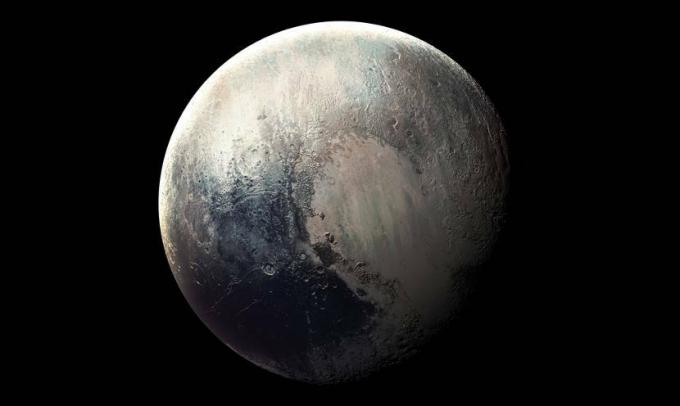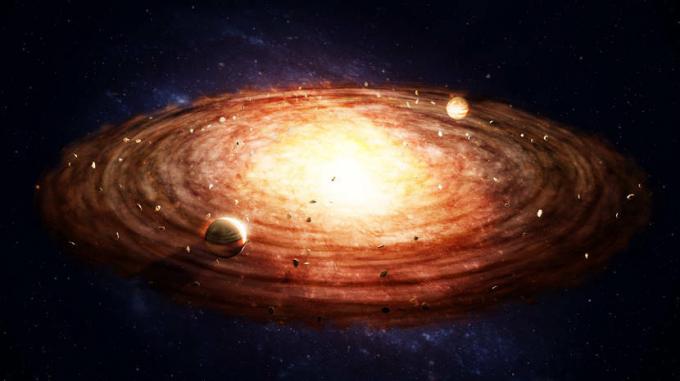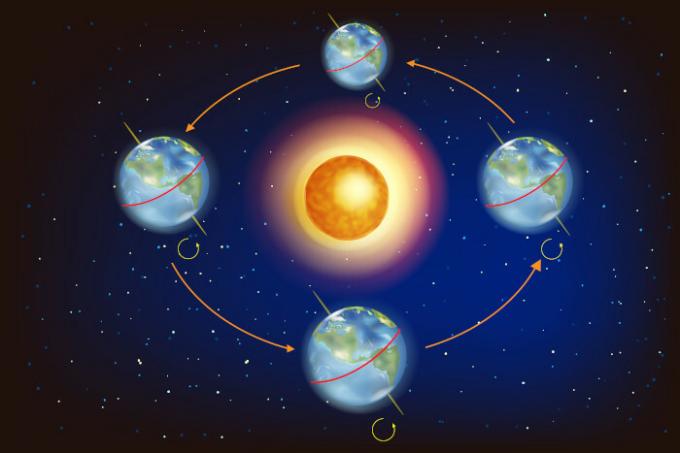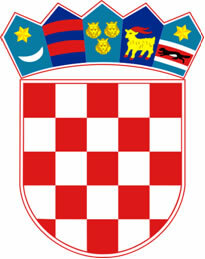O Solar system constitutes the set of celestial bodies located in the outer arm of the Milky Way, having as its main star the Sun. These celestial bodies are not only the planets but also yours. satellites, frozen bodies like comets, asteroids, meteoroids, dwarf planets, among others. The planets that make up the Solar System orbit around the central star, the Sun, and are then classified according to removal order of this star and its respective compositions.
readalso: Earth atmosphere — composition, function, layers
Planets of the Solar System

Currently the Solar System is formed by eight planets which are, according to the International Astronomical Union, celestial bodies that meet orbiting the sun. These bodies have enough mass to ensure that your gravity enable them to have a rounded shape, known as static equilibrium form.
→ Order of planets in relation to the Sun
The planets are in order according to their proximity to the Sun:
Sun |
Mercury |
Venus |
Earth |
Mars |
Jupiter |
Saturn |
Uranus |
Neptune |
→ Characteristics of the Planets of the Solar System

The characteristics of planets of the solar system they vary according to their formation process and their distance from the Sun. Therefore, they distinguish themselves in their composition, size, localization, temperature, and presence or absence of satellites. Check out the main characteristics of each planet below:
Mercury
- Rocky planet closest to the Sun, being 57,910,000 km away.
- It is the smallest planet in the Solar System.
- The temperature can reach 550 °C on its surface.
- Composed of basalts and silicates.
- No satellites.
- Atmosphere composed of lesser amounts of helium and hydrogen.
Venus
- Rocky planet known as Estrela Dalva, very visible to the naked eye.
- It is 108,200,000 km from the Sun.
- Temperature can reach 460°C.
- Consisting of silicates and basalts.
- It has no natural satellites.
- Atmosphere composed of nitrogen, carbon dioxide and water vapor.
- It is the planet we live on and the only one that presents favorable conditions for the existence of life.
- It is 149,600,000 km from the Sun.
- The average temperature on the planet is 14°C.
- Consisting of silicates and basalts.
- It has a natural satellite, the Moon.
- Atmosphere composed of nitrogen, oxygen, water vapor and other gases.
readmore:Clouds — learn about the most important aspects of these clusters
Mars
- Rocky planet known as Red Planet, due to its reddish color coming from its soil rich in silicon and iron.
- It is 227,940,000 km from the Sun.
- The temperature on Mars varies between -76°C and -10°C.
- Consisting of silicates and basalts.
- It has two natural satellites.
- Atmosphere composed of carbon dioxide, nitrogen, carbon monoxide and traces of oxygen.
Jupiter
- Gas planet considered the largest in the Solar System.
- It is located at 778.330,000 km from the Sun.
- The temperature on the planet can reach -100°C.
- Consisting of gases such as hydrogen, helium and methane.
- It has six natural satellites.
Saturn
- A gas planet known for its ice rings.
- It is 1,429,400,000 km from the Sun.
- The temperature on the planet can reach -140°C.
- Consisting of gases such as hydrogen, helium and methane.
- It has 18 natural satellites.
Uranus
- Gas planet, considered the third largest in the Solar System.
- It is located at 2,880,990,000 km from the Sun.
- Temperature on the planet can reach -200°C.
- Consisting of gases such as hydrogen, helium and methane.
- It has about 27 natural satellites.
Neptune
- Blue-colored gaseous planet due to the presence of methane, it is the last in the Solar System.
- It is located 4,504,300,000 km from the Sun.
- Temperature on the planet can reach -218°C.
- Consisting of gases such as hydrogen, helium and methane.
- It has about 13 natural satellites.
Pluto

until the year of 2006, Pluto made up the set of planets in the Solar System. Starting that year, the International Astronomical Union, which regulates definitions, nomenclatures and classifications in astronomy, announced a new definition for the word planet. This change resulted from new astronomical discoveries regarding the existence of celestial bodies that resembled Pluto.
Therefore, it would be necessary to increase the number of planets in the Solar System or create a new classification for these bodies. The UAI then presented, together with the definition of planet, the definition of dwarf planet, how is it now classified Pluto and the other celestial bodies with similar characteristics. Currently, the Solar System is therefore composed of eight planets and five dwarf planets:
- Ceres
- Pluto
- eris
- haumea
- make make
Lookmore: What is the center of the Earth like?
→ Classification of planets
The classification of planets is based on their composition and proximity to the Sun. there are the planets of higher density and the planets of low density, being then classified as follows:
Rocky, interior, telluric or terrestrial planets
Rocky planets are the planets with the highest density and the closest to the Sun. They basically consist of rocks and heavy metals such as iron. They are: Mercury, Venus, Earth and Mars.
Gaseous, exterior, Jovian or giant planets
gas planets they are the planets with the lowest density and the most distant from the Sun. They consist of gases such as hydrogen, helium gas, methane and carbon dioxide. They are: Jupiter, Saturn, Uranus and Neptune.
Sun
the sun is the central star of the solar system. Considered an average star, the Sun has diameter about, 1.39 billion km (109 times that of Earth), and its mass is about 332,900 times that of our planet. Basically the star is formed by hydrogen (approximately 90%) and helium (9%). The Sun is composed of:
- Photosphere: it is the visible part of the sun that emits light propagated in space, and the phenomenon known as sunspot can be noticed.
- Core: it is the central part of the Sun that concentrates approximately half of the star's total mass. The temperature in this region reaches about 15,000,000°C.
- Chromosphere: it is a thin, rarefied and invisible layer of the Sun. The temperature of this region varies according to the distance from the core.
- Solar crown: is the outermost part of the Sun, above the photosphere, and can only be observed in eclipses totals.
Origin of the Solar System

There are several theories about the origin of the Solar System, so there is no consensus on this matter. Many scholars believe that this was formed approximately 4.7 billion years. The theory that most satisfies the astronomical community is known as the Solar Nebula Theory, formulated in 1644 by René Descartes and reformulated in 1775 by Immanuel Kant and later in 1796 by Pierre-Simon de Laplace.
The Solar Nebula Theory believes that the formation of the Sun occurred through the rotation of a cloud which, when undergoing contraction, influenced by gravity, collapsed due to the high speed at which it was. That collapse gave rise, through the central concentration of the nebula, to the Sun. already the planets resulted from remaining particles of the collapsing molecular cloud.
The reformulation of the theory adds that the planets formed in the regions farther from the center of the nebula which gave rise to the Sun. In these regions the temperature was lower, the volatile substances underwent condensation, while in the regions of higher temperature, these substances were lost, allowing the classification of planets into rocky and gaseous.
Solar System Stars
In addition to the planets and the Sun, the Solar System is made up of other celestial bodies. These, according to the UAI, are known as Small Bodies of the Solar System. Are they:
comets |
Celestial bodies formed by a solid part (nucleus), ice and impurities. As it approaches the Sun, this ice evaporates and dust grains eject themselves, causing sunlight to reflect. This explains the shiny appearance of comets. As they move, they have a tail, which is nothing more than an extension of the cloud of gas and dust reflecting light. Comets are irregular and often large. |
asteroids |
Celestial bodies whose brightness is not constant, given the ability to reflect sunlight. These bodies have their own movement. More than 3000 asteroids have been catalogued, and most of these have elliptical orbits, lying in the asteroid belt (between Jupiter and Mars). There are few asteroids that have dimensions greater than 240 km. |
Meteors / Meteoroids / Meteorites |
Meteors, meteoroids and meteorites are not defined the same way. Meteor, contrary to what many believe, is the luminous phenomenon that can be observed while a meteoroid passes through the atmosphere. Meteoroids are the remains of comets or fragments from asteroids. Meteorites are meteoroids that did not get lost when entering the earth atmosphere, thus managing to reach the Earth's surface. |
coloring page

*To download the PDF image, Click here!


